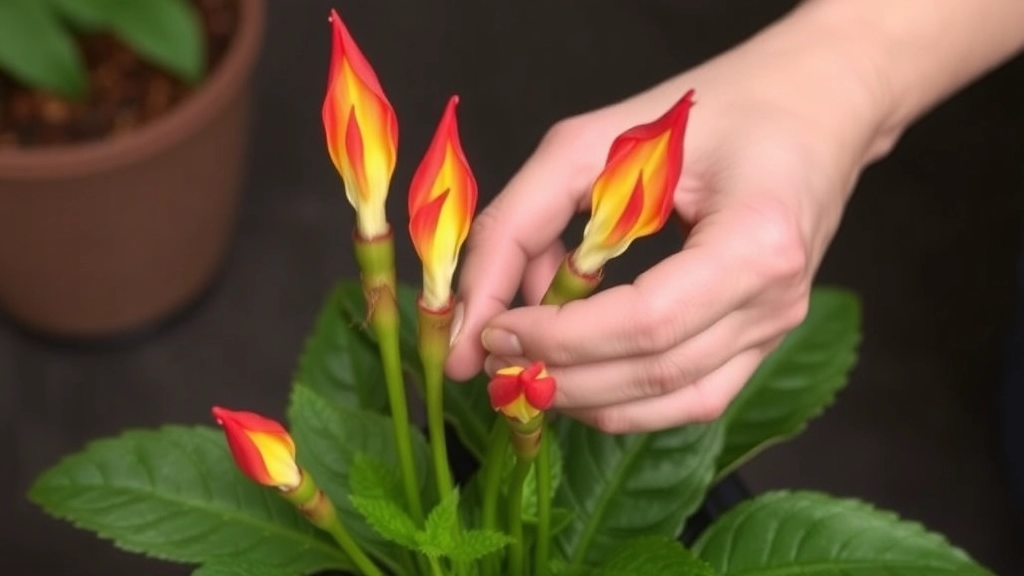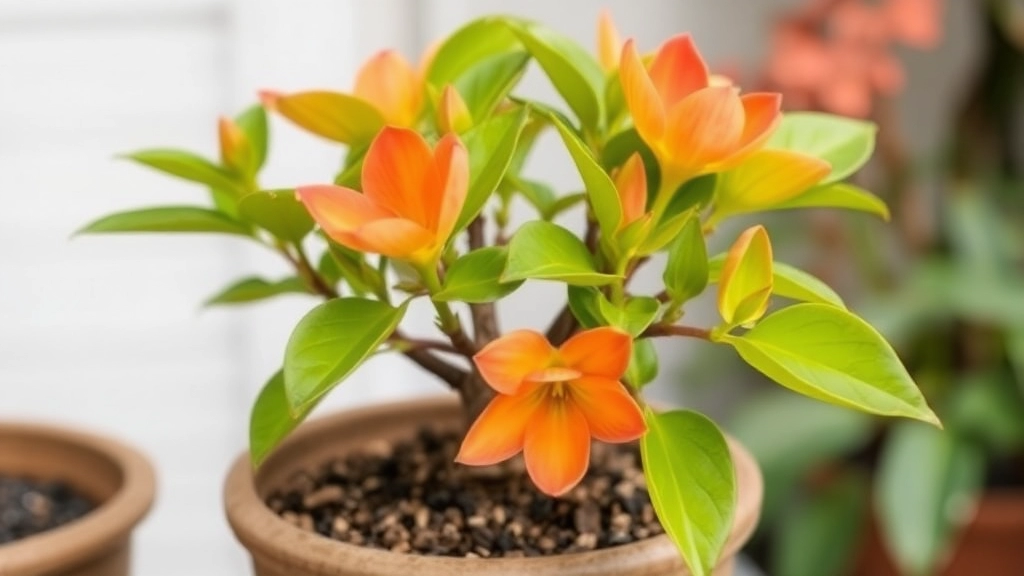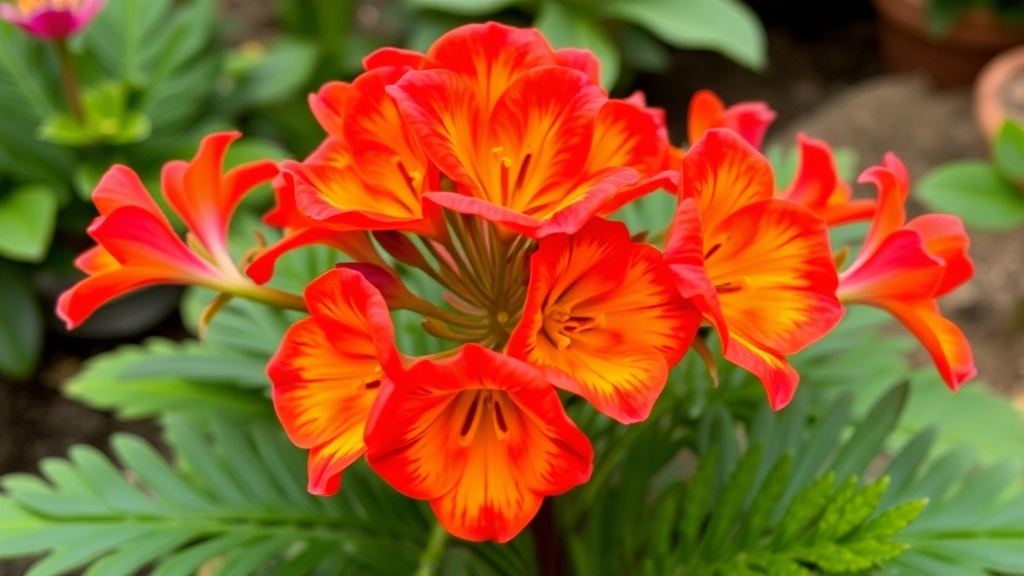Caring for Your Kalanchoe Flaming Katy
When it comes to caring for your Kalanchoe Flaming Katy, understanding its basic needs is crucial. This vibrant succulent thrives in bright, indirect light and requires minimal watering, making it an ideal choice for both novice and experienced gardeners. Ensuring your Flaming Katy receives the right amount of light and water will keep its blooms healthy and vibrant.
Choosing the Right Soil and Potting Mix
Choosing the right soil and potting mix is another key aspect of maintaining a healthy Flaming Katy. Opt for a well-draining soil mix to prevent root rot and ensure your plant’s longevity. Additionally, fertilising your Flaming Katy during its growing season will promote lush blooms and vigorous growth.
Simple Steps for Care
By following these simple steps, you can enjoy the beauty of your Flaming Katy all year round.
When it comes to caring for your Flaming Katy, understanding its basic needs is essential. You might be wondering, “What kind of light does my plant need?” or “How often should I water it?” Let’s break this down into manageable tips.
### Light Requirements
Flaming Katy, or Kalanchoe blossfeldiana, thrives in bright, indirect sunlight.
– **Optimal Location:** Place your plant near a window where it can receive 6 hours of light daily.
– **Avoid Direct Sun:** Too much direct sunlight can scorch the leaves, so filtered light is best.
### Watering Guidelines
Watering can be a tricky balance, but here’s how to get it right.
– **Frequency:** Water when the top inch of soil feels dry.
– **Method:** Ensure you water thoroughly until it drains from the bottom, but avoid letting it sit in water. Overwatering can lead to root rot. For more detailed advice, check out these [optimal watering tips for healthy Florist Kalanchoe](https://planthq.org/optimal-watering-tips-for-healthy-florist-kalanchoe/).
### Temperature Preferences
Temperature plays a significant role in the health of your Flaming Katy.
– **Ideal Range:** It prefers temperatures between 18-24°C (65-75°F).
– **Avoid Extremes:** Keep it away from cold drafts and extreme heat, as both can stress the plant. If your plant isn’t flowering, you might find this guide on [why your Florist Kalanchoe is not flowering](https://planthq.org/why-your-florist-kalanchoe-is-not-flowering-causes-and-fixes/) helpful.
Choosing the Right Soil and Potting Mix for Flaming Katy

So, you’ve got your Flaming Katy, and now you’re wondering what soil is best for it?
Choosing the right soil is crucial for keeping your plant healthy and vibrant.
Key Considerations for Soil Selection
- Well-Draining Mix: Flaming Katy loves a well-draining soil.
- Look for potting mixes designed for succulents or cacti.
- You can also create your own by mixing regular potting soil with sand or perlite for that extra drainage.
- pH Level: Aim for a slightly acidic to neutral pH, around 6.0 to 7.0.
- This helps your Flaming Katy absorb nutrients efficiently.
- Nutrient-Rich: While they aren’t heavy feeders, a soil mix with some organic matter can boost growth.
- Consider adding compost or worm castings for that nutrient kick.
Potting Mix Tips
- Avoid Heavy Soils: Stay away from dense, clay-like soils. They retain too much moisture, which can lead to root rot.
- Check for Additives: Some potting mixes come with slow-release fertilizers.
- This can be beneficial, but make sure it’s not too much for your Flaming Katy.
- Repotting: When you repot, always refresh the soil.
- This keeps nutrients up and prevents compacted soil that can suffocate roots.
Fertilizing Your Flaming Katy: Best Practices for Vibrant Blooms
When it comes to keeping your Flaming Katy thriving, fertilization is key to achieving those stunning blooms. You might be wondering how to effectively nourish your plant without overwhelming it.
Understanding Nutritional Needs
Flaming Katy, or Kalanchoe blossfeldiana, benefits from regular feeding to support its growth and flowering. Here are some straightforward tips for fertilising your plant:
- Frequency: Fertilise every 4-6 weeks during the growing season (spring and summer).
- Type of Fertiliser: Use a balanced, water-soluble fertiliser with an NPK ratio of 15-30-15. This will provide the essential nutrients for vibrant blooms.
- Dilution: Always dilute the fertiliser to half the recommended strength to avoid burning the roots.
Application Tips
To ensure your Flaming Katy absorbs the nutrients effectively, follow these simple steps:
- Water First: Water the plant a day before fertilising to reduce the risk of root burn.
- Apply Evenly: Distribute the fertiliser evenly around the base of the plant, avoiding the leaves.
- Monitor: Keep an eye on your plant. If you notice yellowing leaves, it may be a sign of over-fertilisation.
Seasonal Adjustments
As the seasons change, so should your fertilisation approach:
- Spring/Summer: Stick to the regular schedule for maximum growth.
- Autumn/Winter: Reduce or stop fertilisation as the plant enters dormancy.
By following these best practices, your Flaming Katy will flourish and reward you with a dazzling display of blooms. For more detailed care instructions, check out our Flowering Kalanchoe Blossfeldiana Care Guide. If you’re interested in growing this plant from seeds, our guide on how to grow Kalanchoe Blossfeldiana from seeds will be very helpful.
Common Pests and Diseases: How to Protect Your Flaming Katy
As you nurture your Flaming Katy, you may encounter some common pests and diseases that can threaten its health. Understanding how to identify and manage these issues is crucial for maintaining vibrant blooms and lush foliage.
Common Pests
- Mealybugs
Look for cotton-like clusters on leaves and stems.
Treat with insecticidal soap or neem oil. - Spider Mites
Fine webbing and yellowing leaves are signs.
Increase humidity and use miticides if needed. - Aphids
Small, green or black insects on new growth.
Spray with water to dislodge or use insecticidal soap. - Scale Insects
Brown, shell-like bumps on stems and leaves.
Remove by hand or apply horticultural oil.
Common Diseases
- Root Rot
Caused by overwatering; look for wilting and brown roots.
Ensure proper drainage and allow soil to dry out. - Powdery Mildew
White, powdery spots on leaves.
Improve air circulation and treat with fungicides. - Leaf Spot
Dark spots on leaves, often due to fungal infections.
Remove affected leaves and avoid overhead watering.
Prevention Tips
- Regular Inspection: Check your Flaming Katy weekly for signs of pests or diseases.
- Proper Watering: Avoid overwatering; let the soil dry between watering sessions.
- Good Air Circulation: Ensure your plant has enough space to breathe.
- Healthy Soil: Use well-draining soil to prevent root issues.
Pruning and deadheading are essential practices for maintaining the health and vibrancy of your Flaming Katy. You might wonder, “How can I keep my plant blooming beautifully?”
**Why Prune?**
Pruning helps:
– **Encourage New Growth**: By removing old or dead leaves, you allow the plant to focus its energy on new growth.
– **Shape the Plant**: Regular pruning helps maintain a tidy appearance and encourages a bushier growth habit.
– **Prevent Disease**: Removing infected or damaged leaves can help prevent the spread of pests and diseases.
**When to Prune**
– **After Blooming**: The best time to prune your Flaming Katy is right after it finishes flowering. This timing ensures you don’t cut off any buds that are yet to bloom.
– **Regular Maintenance**: You can also lightly prune throughout the growing season to maintain shape.
**How to Prune**
1. **Use Clean Tools**: Always use sharp, clean scissors or pruning shears to prevent infection.
2. **Remove Dead Leaves**: Cut away any yellow or wilted leaves at the base.
3. **Trim Excess Growth**: For leggy plants, trim back stems to encourage denser growth.
4. **Shape the Plant**: Aim for a rounded shape by selectively pruning branches.
**Deadheading for Continuous Blooms**
Deadheading is the process of removing spent flowers. This encourages your Flaming Katy to produce more blooms.
– **Identify Spent Flowers**: Look for flowers that have wilted or lost their colour.
– **Pinch or Cut**: Use your fingers or scissors to remove the flower just above the first set of leaves.
**Tips for Successful Pruning and Deadheading**
– **Frequency**: Regularly check your plant, especially after blooming, to keep it healthy.
– **Observe Growth Patterns**: Pay attention to how your plant responds to pruning and adjust your techniques accordingly.
For more detailed advice on maintaining your Kalanchoe plants, check out our [pruning tips for Kalanchoe plants](https://planthq.org/pruning-kalanchoe-plants-best-tips-and-techniques/) and [how to care for Kalanchoe succulents](https://planthq.org/how-to-care-for-a-kalanchoe-succulent-expert-tips/).
Propagating Flaming Katy: Simple Steps for New Plants

So, you’re loving your Flaming Katy and thinking, “How can I get more of these beauties?”
Great question! Propagating Flaming Katy is not only easy but also super rewarding.
1. Choose the Right Time
- Spring or Early Summer: This is the best time for propagation when the plant is actively growing.
2. Gather Your Tools
- Sharp Knife or Scissors: Ensure they’re clean to prevent infection.
- Small Pot or Container: For your new plants.
- Well-Draining Soil: A cactus mix works wonders.
3. Take Cuttings
- Select Healthy Stems: Look for strong, healthy stems to cut.
- Cut Below a Leaf Node: This is where new roots will grow.
4. Let Them Callous
- Dry the Cuttings: Place them in a warm spot for a few hours or overnight. This helps prevent rot.
5. Plant the Cuttings
- Insert into Soil: Stick the cut end into your potting mix, about an inch deep.
- Water Lightly: Just enough to moisten the soil, but don’t soak it.
6. Provide the Right Environment
- Warm and Bright: Place your pot in a warm spot with indirect sunlight.
- Keep Soil Moist: Water when the top inch of soil feels dry.
7. Wait for Roots
- Patience is Key: In a few weeks, you should see new growth, indicating that roots are forming.
8. Transition to Care
- Once Established: Treat your new Flaming Katy like an adult plant with regular care.
Seasonal Care for Flaming Katy: Indoor and Outdoor Tips
As we transition from one season to another, the care requirements for your Flaming Katy can change significantly. Understanding these seasonal needs is key to keeping your plant thriving.
Spring: Awakening Growth
In spring, Flaming Katy starts to show signs of new growth.
- Light: Ensure your plant receives bright, indirect sunlight for at least six hours a day.
- Water: Increase watering as the soil dries out more quickly. Aim for a balance to avoid overwatering.
- Fertilising: Begin fertilising every four to six weeks with a balanced fertiliser to encourage blooming.
Summer: Peak Blooming Season
Summer is when your Flaming Katy will likely produce the most vibrant flowers.
- Light: Maintain bright light, but be cautious of direct sunlight during the hottest parts of the day.
- Water: Water regularly, allowing the top inch of soil to dry out between watering sessions.
- Humidity: If outdoors, ensure it’s not exposed to heavy rain. Indoors, keep humidity levels moderate.
Autumn: Preparing for Dormancy
As autumn arrives, your Flaming Katy will start to slow down.
- Light: Continue providing bright light but be prepared to adjust as daylight hours decrease.
- Water: Reduce watering frequency. Allow the soil to dry out more completely between waterings.
- Fertilising: Stop fertilising as the plant prepares for dormancy.
Winter: Rest and Recovery
Winter is a crucial time for your Flaming Katy to rest.
Repotting and Long-term Care for Flaming Katy

So, you’ve got your Flaming Katy thriving, but how do you keep it that way long-term?
Repotting is an essential part of maintaining a healthy plant.
When to Repot:
- If you notice roots growing out of the drainage holes.
- If the soil dries out too quickly.
- If the plant looks top-heavy or is leaning.
Steps to Repot:
- Choose a pot slightly larger than the current one.
- Use a well-draining potting mix, like a cactus or succulent blend.
- Gently remove the plant from its old pot, being careful not to damage the roots.
- Place it in the new pot, filling in with fresh soil and ensuring it’s stable.
Long-term Care Tips:
- Watering: Once the plant is established in its new pot, water it thoroughly, then let the top inch of soil dry out before watering again.
- Light: Keep it in bright, indirect light. Too much direct sunlight can scorch those lovely leaves!
- Temperature: Flaming Katy loves warmth. Keep it in a spot that’s between 18-24°C (65-75°F).
Signs Your Plant Needs Attention:
- Yellowing leaves? Might be overwatering.
- Droopy stems? Check for pests or root rot.
I remember a time when I neglected my Flaming Katy and it started to droop. A quick repotting and a little TLC brought it back to life!
Different Varieties of Flaming Katy and Their Unique Features
As we delve into the fascinating world of Flaming Katy, it’s important to note that this vibrant plant comes in various varieties, each boasting unique features. Understanding these differences can help you choose the perfect type for your space or gardening style.
Popular Varieties of Flaming Katy
-
Kalanchoe blossfeldiana
- Description: This is the most common variety, known for its bright, clustered blooms.
- Flowers: Comes in a range of colours, including red, pink, yellow, and white.
- Height: Typically grows up to 30 cm.
-
Kalanchoe tomentosa (Panda Plant)
- Description: Recognised for its fuzzy leaves and unique appearance.
- Flowers: Produces tubular flowers, usually in a soft orange or yellow.
- Height: Can reach up to 45 cm.
-
Kalanchoe luciae (Flapjacks)
- Description: Known for its large, flat leaves that resemble pancakes.
- Flowers: Generates tall flower spikes with small, tubular blooms.
- Height: Grows up to 60 cm, making it a striking addition to any collection.
-
Kalanchoe beharensis (Mother of Thousands)
- Description: Features thick, textured leaves and a bushy appearance.
- Flowers: Produces small, tubular flowers in clusters.
- Height: Can grow up to 1 metre tall, ideal for larger spaces.
Choosing the Right Variety
When selecting a Flaming Katy variety, consider the following:
- Space: Some varieties grow taller and wider than others. Measure your available space to ensure a good fit.
- Light Requirements: While all varieties enjoy bright light, some may need more direct sunlight than others.
- Aesthetic Preferences: Think about the colours and shapes that appeal to you. Each variety has its unique charm.
By understanding the different varieties of Flaming Katy, you can make an informed choice that complements your home or garden beautifully. For more detailed care tips, check out our Complete Care Guide for Kalanchoe Flapjack Plant and our Guide on Caring for the Panda Plant.
FAQs on Kalanchoe Flaming Katy
What type of soil is best for Flaming Katy?
Flaming Katy thrives in a well-draining soil mix. Look for potting mixes designed for succulents or cacti, or create your own by mixing regular potting soil with sand or perlite.
What pH level should the soil have?
A slightly acidic to neutral pH, around 6.0 to 7.0, is ideal for Flaming Katy. This helps the plant absorb nutrients efficiently.
How often should I repot my Flaming Katy?
Repot your Flaming Katy when you notice roots growing out of the drainage holes, the soil dries out too quickly, or the plant looks top-heavy. Generally, repotting every 1-2 years is recommended.
What are common pests that affect Flaming Katy?
Common pests include mealybugs, spider mites, aphids, and scale insects. Regular inspection and proper care can help manage these pests effectively.
How can I prevent root rot in Flaming Katy?
To prevent root rot, ensure proper drainage and avoid overwatering. Let the soil dry out between watering sessions.
When is the best time to propagate Flaming Katy?
The best time to propagate Flaming Katy is during spring or early summer when the plant is actively growing.
What tools do I need for propagating Flaming Katy?
You will need a sharp knife or scissors, a small pot or container, and well-draining soil for successful propagation.
How should I care for Flaming Katy after repotting?
After repotting, water the plant thoroughly and allow the top inch of soil to dry out before the next watering. Keep the plant in bright, indirect light and maintain a warm environment between 18-24°C (65-75°F).
What are signs that my Flaming Katy needs attention?
Yellowing leaves may indicate overwatering, while droopy stems could be a sign of pests or root rot. Regular monitoring and proper care can help address these issues promptly.
How do I manage common diseases in Flaming Katy?
For root rot, ensure proper drainage and allow the soil to dry out. Powdery mildew can be treated by improving air circulation and using fungicides. Leaf spot can be managed by removing affected leaves and avoiding overhead watering.
References
-
Flaming Katy Care: Tips For Growing Flaming Katy Plants
-
How to Grow and Care for Flaming Katy (Kalanchoe blossfeldiana)
-
Flaming Katy – House Plants Expert
